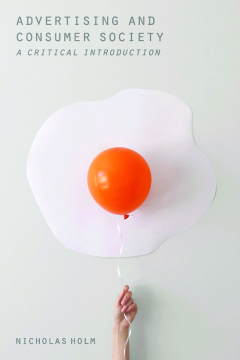
Additional Information
Book Details
Abstract
An introduction to the critical study of advertising, exploring its role in our contemporary cultural landscape and its connections to larger economic, social and political forces. Written in an engaging and accessible style, the book provides students with the key concepts, methods and debates you need to analyse and understand advertising.
An engaging and accessible introduction to the critical study of advertising, which provides students with the key concepts, methods and debates they need to analyse and understand advertising.
Nick Holm is Lecturer of Media Studies at Massey University, New Zealand.
Table of Contents
| Section Title | Page | Action | Price |
|---|---|---|---|
| Cover | Cover | ||
| Contents | v | ||
| Chapter 1: Introduction: Why study advertising? | 1 | ||
| Why study advertising? | 2 | ||
| Reason one: Advertising is everywhere | 4 | ||
| Reason two: Advertising is weird | 4 | ||
| Reason three: Advertising is where the money is | 5 | ||
| Reason four: Advertising is beautiful, inspiring and entertaining | 7 | ||
| Reason five: Advertising is political | 8 | ||
| What this book is about | 9 | ||
| What this book is not about | 12 | ||
| Chapter 2: The history of advertising: Contexts, transformations and continuity | 14 | ||
| Four moments in advertising history | 15 | ||
| The first moment: Origins, industrialisation and development | 16 | ||
| The second moment: Professionalisation, consolidation and redemption | 20 | ||
| The third moment: Manipulation, creativity and globalisation | 24 | ||
| The fourth moment: Digital advertising, algorithms and dataveillance | 28 | ||
| The changing nature of advertising | 32 | ||
| Chapter 3: Analysing advertisements: Form, semiotics and ideology | 35 | ||
| Advertising contexts, codes and conventions | 36 | ||
| Semiotic analysis of advertising | 44 | ||
| Mythology and ideology | 52 | ||
| Careful reading | 61 | ||
| Chapter 4: Advertising, capitalism and ideology | 63 | ||
| What is capitalism? | 63 | ||
| What is political economy? | 67 | ||
| What is ideology? | 70 | ||
| Consumer society and the magic system | 80 | ||
| Selling capitalism | 85 | ||
| From economics to ideology to advertising | 90 | ||
| Chapter 5: Advertising commodities and commodity fetishism | 93 | ||
| What is a commodity? | 95 | ||
| Advertising and commodity fetishism | 99 | ||
| Fetishism and consumerism | 112 | ||
| The life cycle of the commodity | 114 | ||
| Chapter 6: Audiences for sale: Quantification segmentation and personalisation | 117 | ||
| The audience as commodity | 118 | ||
| Breaking down the audience: Fragmentation, segmentation and distinction | 124 | ||
| Conspicuous consumption | 129 | ||
| From nichification to personalisation | 133 | ||
| Same but different? | 137 | ||
| Chapter 7: Advertising agencies: Organisation agency and internal conflict | 142 | ||
| The limits of abstraction | 142 | ||
| The organisational structure of agencies | 146 | ||
| The changing agency | 151 | ||
| Advertisers in their own voices | 153 | ||
| Conflict and compromise in the agency | 159 | ||
| Agency as form from chaos | 160 | ||
| Chapter 8: Advertising as art: From creativity to critique | 162 | ||
| Advertising and ‘creativity’ | 163 | ||
| Advertising and art | 168 | ||
| Advertising changing the world | 177 | ||
| The stakes of advertising as art | 180 | ||
| Chapter 9: Empowering consumers Engagement interpretation and resistance | 181 | ||
| The active advertising audience | 182 | ||
| What does the audience get from advertising? | 187 | ||
| Active audiences online | 195 | ||
| Activist resistance to advertising | 198 | ||
| Chapter 10: The politics of advertising: Capitalism, resistance and liberalism | 201 | ||
| The politics of capitalism | 202 | ||
| The politics of agency | 205 | ||
| The politics of art | 207 | ||
| The power of advertising | 208 | ||
| References | 210 | ||
| Index | 219 |
